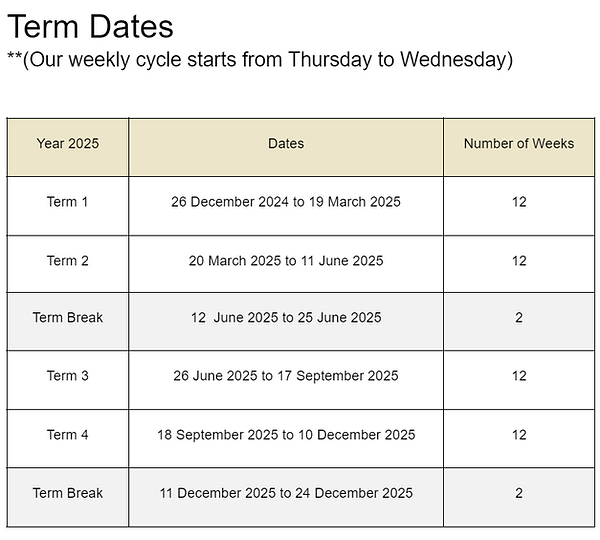Our
Classes
Culture of Nurture
We are made up of a diverse team of educators highly skilled in their craft with years of experience in different education establishments. All our teachers and staff are personally handpicked and trained in The Ikigai Math Method and Pedagogy, with every individual chosen for their passion, attitude and their teaching style which is strongly aligned with the centre's philosophy.
The Ikigai Math learning journey follows a structured learning process. Students will receive a class booklet which covers the content delivered during each class. Students are brought into the world of math through an interactive class experience with our math trainers and concepts covered will be highly reinforced through the homework booklet.
Each classroom is supported with a projector and whiteboard for trainers to conduct the class effectively. In addition, manipulatives and hands-on learning materials are also provided to support and enhance the learning experience.
Our Classes
Our curated and well-supported curriculum are the building blocks in attaining a mastery in Mathematics. Ikigai Math prepare its students and not just for examinations, but also for lifelong education and learning.
Our proprietary Ikigai Method is a skills-based approach that targets students to think logically, analyse concepts accurately and apply insights effectively.
Our curriculum and learning journey is purposefully designed to support your child in the best way possible.
Feedback is also provided to parents at key highlight periods in their learning journey. If you have enrolled your child with us, feel free to email us at info@ikigaimath.com anytime.

What is covered
in The Ikigai Math programme?
Our Programme

The Ikigai Math programme offers a year long programme for Primary One to Primary Six students. The classes are conducted by a highly experienced and hand-selected team of teachers who imparts The Ikigai Method and is fully aligned with the Math MOE syllabus and more.
Students are mentored through The Ikigai Method and is well-prepared to face any challenges in their academic journey leading up to their PSLE. Students also work within a clear framework and are well-supported through the comprehensive curriculum coverage.
The Ikigai Method is also brought to life through the nurturing environment we put our students in. They are supported through emotional learning and learn in a holistic environment to achieve their micro-wins in class, working towards their macro-wins in life.
Speak with our team through a 1:1 Discovery Call to learn how the Ikigai Math Programme can help your child win in life!
Primary 1
Numbers to 100
Addition to 100
Subtraction to 100
Ordinal Numbers
2D Shapes
Length
Picture graphs
Multiplication
Division
Time
Money
Model Drawing
Working Backwards
Number Patterns
Learning Focus:
Foundation building
Spur Interest
Actively Engage
Nurture Understanding
Primary 2
Numbers to 1000
Addition to 1000
Subtraction to 1000
Multiplication
Division
Fractions
Money
2D/3D Shapes
Length, Mass, Volume
Picture, Graph, Scales
Time
Model Drawing
Working Backwards
Number Patterns
Guess and Check
Gaps and Intervals
Constant Difference (Age Gap)
Restate the Problem
Sets/Grouping
Stack Model
Internal Transfer
Learning Focus:
Foundation building
Spur Interest
Actively Engage
Nurture Understanding
Primary 3
Numbers to 10 000
Addition and Subtraction-
to 10 000
Multiplication
Division
Fractions
Bar graphs
Guess and Check
Pattern figures
Geometry -
Angles, Perpendicular lines
Parallel line
Measurement-
Length, Mass, Volume
Area and Perimeter
Time
Working Backwards
Supposition Method
Excess and Shortage
Comparing Multiple Quantity
Gaps and Intervals
Internal/External Transfer
Age Difference
Restate the Problem
Equal stage
Sets/Grouping
Learning Focus:
Intermediate Problem Solving
Skill Mastery
Exam Exposure
Primary 4
Whole numbers within 100 000 Factors and multiples
Four operations of whole numbers
Decimals
Four operations of decimals Table, line graphs , pie chart Fractions
Geometry –
angles, rectangle, square, Nets, Line
Symmetry
Working backwards Supposition method
Number x value
Excess and shortage – listing/model
Comparing multiple quantity
Internal /External transfer
Sets/ grouping
Gaps and intervals
Equating numerator, part whole relationship
Restate the problem
Equal stage
Pattern figures
Redistribution
Learning Focus:
Intermediate Problem Solving
Skill Mastery
Exam Exposure
Primary 5
Whole numbers to 10 million
Four operations of whole numbers
Fractions
Four operations of fractions
Area of triangle
Volume of cube and cuboid
Four operations of Decimals
Rate Percentage
Geometry –
Angles Properties of a triangle, parallelogram, rhombus, trapezium
Comparing multiple quantities Internal/external transfer Excess and shortage
Working backwards
Number x value
Supposition
Equating numerator Comparing difference
Gaps and intervals
Unitary transfer
Learning Focus:
Advanced Problem Solving
Critical-Thinking
In-depth Understanding
Exam Skills
Primary 6
Four operations of whole numbers and fractions Percentage
Ratio
Rate
Speed
Algebra
Circles
Volume
Angles
Nets
Pie charts
Number patterns
Comparing multiple quantities Internal/external transfer
Unitary transfer
Supposition
Equating numerators
Part-whole relationship Comparing difference Constant difference Unchanged variable
Units and parts
Constant total
Non-routine questions
Learning Focus:
Advanced Problem Solving
Critical-Thinking
In-depth Understanding
Exam Skills
Secondary 1
Factors and Multiples
Real Numbers
Approximation and Estimation Basic Algebra and Algebraic Manipulations
Simple Equations in One Variable
Angles and Parallel Lines Triangles, Quadrilaterals and Other Polygons
Ratio, Rate and Speed Percentage
Sequences and Number Patterns
Linear Functions
Perimeter and Area of Plane Figures
Volume and Surface Area
Data Handling
Learning Focus:
Advanced Problem Solving
Critical-Thinking
In-depth Understanding
Exam Skills
Secondary 2
Linear Graphs and Simultaneous Linear Equations
Linear Inequalities
Expansion and Factorisation of Algebraic Expressions
Expansion and Factorisation using Special Algebraic Identities
Quadratic Equations and Graphs
Algebraic Fractions and Formulae
Direct and Inverse Proportions
Congruence and Similarity
Pythagoras’ Theorem
Trigonometric Ratios
Volume and Surface Area of Pyramids, Cones and Spheres
Probability of Single Events
Statistical Diagrams
Averages of Statistical Data
Learning Focus:
Advanced Problem Solving
Critical-Thinking
In-depth Understanding
Exam Skills
Secondary 3 E Math
More about Quadratic Equations and Quadratic Functions
More about Linear Inequalities
Indices
Coordinate Geometry
Functions and Graphs
Conditions of Congruence and Similarity
Further Trigonometry
Application of Trigonometry Arc Lengths, Sector Areas and Radian Measure
Properties of Circles
Learning Focus:
Advanced Problem Solving
Critical-Thinking
In-depth Understanding
Exam Skills
Secondary 3 A Math
Quadratic Functions
Equations and Inequalities
Surds
Polynomials and Partial Fractions Exponential and Logarithmic Functions and Equations
Binomial Expansions
Coordinate Geometry and Linear Law
Learning Focus:
Advanced Problem Solving
Critical-Thinking
In-depth Understanding
Exam Skills
Secondary 4 E Math
Set Language and Notation
Data Analysis – Measure of Spread Probability
Matrices
Vectors in Two Dimensions
Learning Focus:
Advanced Problem Solving
Critical-Thinking
In-depth Understanding
Exam Skills
Secondary 4 A Math
Differentiation
Integration
Proofs in Plane Geometry
Learning Focus:
Advanced Problem Solving
Critical-Thinking
In-depth Understanding
Exam Skills


How can I sign-up for
classes at Ikigai Math?

Visit one of our centres today!






